
17 Best Places to see Puffins in Scotland
Discover the best places to see Puffins in Scotland in this guide. We’ll share the best places to see Puffins in Scotland, some Puffin facts, links to tours, and tips for viewing and photographing these iconic birds.
ABOUT PUFFINS:
Puffins are one of three species in the bird genus Fratercula. They’re somewhat related to penguins and guillemots. Two species, the Tufted Puffin and Horned Puffin, are found in the North Pacific Ocean. The Atlantic Puffin, which we’ll be discussing here, is the only European species, found in the North Atlantic Ocean.
So what makes Puffins so special? Atlantic Puffins breed in large colonies on coastal cliffs or offshore islands. This is fairly unique, with puffins nesting in crevices among rocks, or digging out burrows in the soil. Some of the best places to see Atlantic Puffins include the UK, Iceland, Greenland, and the Faroe Islands.
WHAT DO PUFFINS LOOK LIKE?
Often called the ‘clown of the sea’, the Atlantic Puffin is an iconic species. Puffins are easily identifiable in the summer months by their tuxedo-like black and white feathers, little orange feet, and brightly coloured characteristic beaks.
Stocky, and smaller than you’d expect, Puffins beat their wings up to four hundred times per minute when flying low over the ocean, which makes a cute little whirring sound. They feed by diving for small fish. Although clumsy on land, Puffins (like penguins) are graceful and agile underwater.
If you want to see Puffins here, in the UK, you’re in luck! You can see Puffins in Scotland! The best places to see Puffins in Scotland are on remote islands such as Lunga, in the Treshnish Isles, Shetland, Orkney, and the distant island of St Kilda. But, you can also see Puffins nearer to Edinburgh and Glasgow too!
Here, we’ll share the best places to see Puffins in Scotland, and in the rest of the UK.
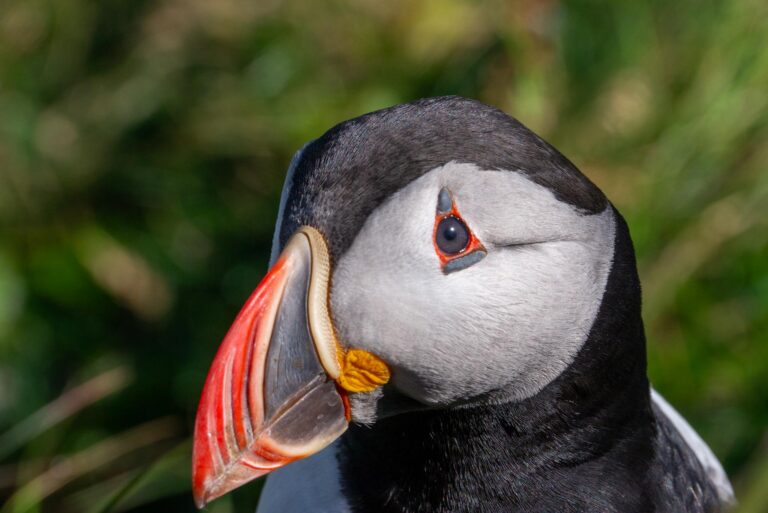
WHY ARE PUFFINS SO SPECIAL?
Atlantic Puffins aren’t an endangered species. But, there are only a few places in the world where you can see them.
Unlike many bird species, a pair of Puffins will stay together for life. They work together to build the nests and burrows, which they return to every year to breed (between March and August). During breeding season, the pair of Puffins take it in turns to either stay with the chick (called a puffling), or to fly out to sea in search of fish.
As they return to the same nests every year, it’s easy to catch these predictable birds at many of their favourite nesting sites around Scotland. Here are some of the best places to see Puffins in Scotland:
THE BEST PLACES TO SEE PUFFINS IN SCOTLAND.
Scotland is a Puffin’s paradise, with miles of rugged coastline cliffs and hundreds of uninhabited islands. These charismatic seabirds, with their colourful beaks and expressive eyes, can be found in several locations across the country.
So, in no particular order, here are some of the best places to see Puffins in Scotland:
#1 SUMBURGH HEAD, SHETLAND
Sumburgh Head is a nature reserve at the southern tip of the main Shetland Island. It’s a prime spot for Puffin watching! Steep, craggy cliffs meet the ferocious North Sea, providing the perfect nesting sites for Puffins to dig their burrows. During the breeding season, from late April to early August, Sumburgh Head comes alive with thousands of Puffins.
You can also spot other seabirds, including Fulmars, Guillemots and Shags. And, if you’re lucky, you may even see Minke Whales, Orcas and dolphins on a calm day. The nearby visitor centre has information about all the local species, and is free to visit (but donations are welcome!).
#2 HERMANESS NATURE RESERVE, SHETLAND
On the northerly tip of the northernmost island of Unst on Shetland, Hermaness Nature Reserve is another excellent location for observing Puffins. Well-maintained trails over dramatic cliffs and scenic landscapes make it a perfect day trip. Most of the seabirds arrive in late April. Visit between April and August to see fulmars, gulls, shags, gannets and kittiwakes.
The moor is truly beautiful: a living tapestry of purple heather, crowberry, bilberry, and soft mosses and grasses. But we think that Hermaness is most beautiful in spring, when the squill plant carpets the coastal grassland in shades of blue.
#3 FAIR ISLE, SHETLAND
Fair Isle, situated between Orkney and Shetland, is renowned for its birdlife. Puffins are a common sight here, greatly outnumbering local residents. Tisland’s remote environment provides a unique birdwatching experience, where you may also catch a glimpse of rare Storm Petrels, Terns, Razorbills, Fulmars, Black Guillemots, and Gannets. The Fair Isle Bird Observatory offers guided tours.
But seeing Puffins on Fair Isle can be a bit of a pain! Fair Isle is located in the middle of the North Sea, between Orkney and the Shetland Islands. To get there, you have to take a small ferry. However, this is frequently cancelled due to weather conditions, regularly cutting Fair Isle off from the rest of Scotland – at least temporarily!
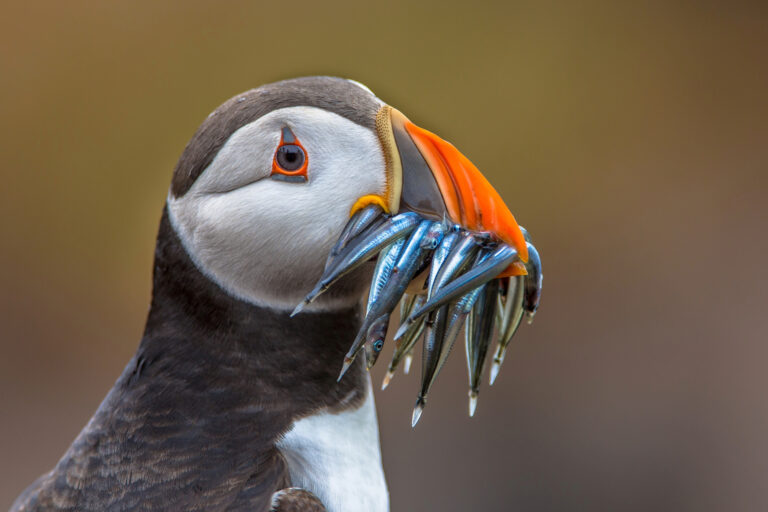
#4 MULL HEAD, ORKNEY
The Orkney Islands may not be the first that spring to mind when thinking about the best places to see Puffins in Scotland. But, they are home to several Puffin colonies. And most importantly, are much easier to get to than the remote Shetland Islands. Just 8 miles from the mainland, the Orkney Islands are the perfect addition to anyone exploring the North Coast, or driving the NC500.
Situated in a remote corner of Orkney, Mull Head is particularly popular, both with Puffins and with people coming to watch them. The sheer cliffs are constantly eroded by the waves, which creates caves and crannies over time – ideal places for Puffins to nest. There’s also a visitor centre with information about the wildlife, landscapes and history.
The seabird colonies here are vibrant, and the area is known for its archaeological sites as well. Mull Head also offers a range of beautiful hikes and trails. Close to the cliff edge, plants such as sea pinks and blue spring squill thrive, and there are several signposted walks (short, 5km and 10km options) to enjoy the area.
#5 LUNGA, TRESHNISH ISLES
Not far from the Isle of Mull are the Treshnish Isles, a small collection of mostly uninhabited islands. Lunga, the largest of the Treshnish Isles, is a favourite among Puffins. And we think it’s one of the best places to see Puffins in Scotland.
Lunga is uninhabited, with just two small boats per day dropping people off to visit for a couple of hours at a time. Thanks to the human population of 0, Lunga’s Puffins are friendly, curious, and incredibly approachable. Lunga is the best place to photograph Puffins (in fact most of the photos in this post were taken by us, on Lunga!). They’ll totally pose for you with their mates, or in front of their burrows.
In locations like Lunga, it’s really important to respect the Puffins’ space. Remember, where there are Puffins, there are burrows, and you don’t want to crush them (or the little puffling inside!). Stay behind the marked white line at all times, and if you spot Puffins and want to get closer, get down on all-fours to spread your weight more evenly. This will help you avoid damaging their nests.
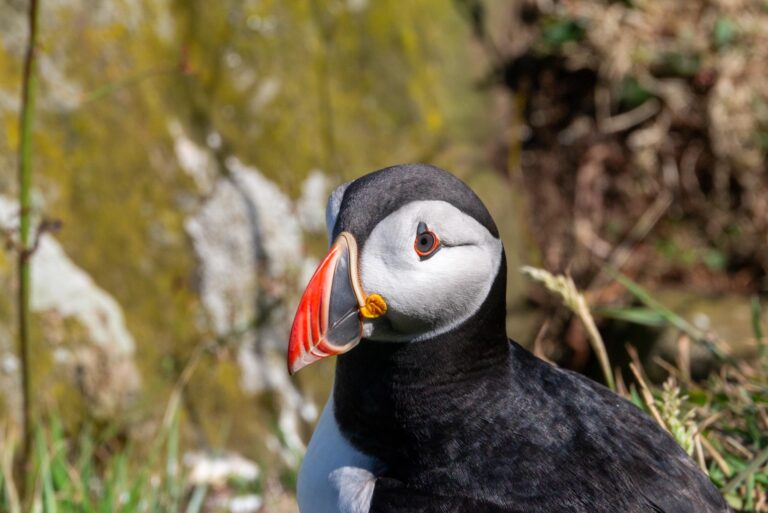
#6 STAFFA, INNER HEBRIDES
Staffa is another island off the coast of Mull. The island is tiny, and most famous for the geological wonder, Fingal’s Cave, which has basalt columns similar to Northern Ireland’s Giant’s Causeway, or Iceland’s Stuðlagil Canyon.
Whilst Fingal’s Cave gives you more than enough reason to visit Staffa, the island is also a great place to spot Puffins and other seabirds. Staffa can only be reached by boat tour from Mull or Iona. Boats sail year-round, but can be disrupted by bad weather, so make sure to plan a few days on mull if this is a must-do, to maximise your chances of sailing. Boat trips to Staffa often include wildlife spotting opportunities.
#7 ST KILDA, OUTER HEBRIDES
The island of St Kilda, ~60 miles from the Outer Hebrides, is the most remote Puffin-watching destination in Scotland. This formerly inhabited island is a UNESCO World Heritage site, and home to over one million seabirds, including the UK’s largest colony of Atlantic Puffins
The history of the island is fascinating. A community existed here for at least 4,000 years, with the final 36 residents evacuating to the mainland in 1930, after their way of life became no longer sustainable.
The journey in itself is an adventure. To get to St Kilda, you have to take a small boat from the Outer Hebrides, such as this tour here. You can visit St Kilda for the day. Or, if you’re feeling adventurous, you can arrange to be dropped off on the island and picked up at a later date for some self-sufficient remote island camping.
#8 ISLE OF MAY, FIFE
Ok, St Kilda is maybe a little too remote, so we’re moving on to some sites on, or close to, the mainland. Particularly the Central Belt, where most visitors to Scotland will start their trip.
Just a stone’s throw from Edinburgh, not far from North Berwick or Anstruther, the Isle of May is a wildlife gem in the Firth of Forth. The island is an established nature reserve, and Puffins are abundant from April to August. It’s one of the easiest places to see Puffins in Scotland if you’re short on time.
The Scottish Seabird Centre runs boat trips to the island between April and September. Due to the Isle of May’s popularity and ease of access, you do have to stick to the trails and paths and may not come as close to the burrows as in other Puffin-spotting places. But there are still countless opportunities to photograph these iconic birds, and the Puffins are (of course) free to go where they please, so there’s every chance to get close to them.

#9 CRUDEN BAY, ABERDEENSHIRE
Heading north to Aberdeenshire, Cruden Bay, with its stunning coastal scenery, is another great spot for seeing Puffins in mainland Scotland. The Puffin burrows are just a short walk from the village, near Slains Castle. A stretch of cliffs provides the perfect spot for nesting Puffin pairs and, whilst Cruden Bay may not be the largest Puffin colony in Scotland, it’s easy to spot the Puffins and observe them, with or without binoculars. The village near Cruden Bay is also worth a visit, and the bay itself is perfect for coastal walks.
#10 BULLERS OF BUCHAN, ABERDEENSHIRE
Just a short drive or a ~3 miles (5 kilometre) walk from Cruden Bay, the Bullers of Buchan is a dramatic collapsed sea cave. The cliffs around the Bullers also have those nooks and crannies that Puffins love to build their nests in, making it an exciting and accessible spot for birdwatching.
The local coastline is stunning, with arches, caves, and low stacks. We recommend exploring the Bullers of Buchan along with Cruden Bay and Slain’s Castle, as part of a half-day coastal walk.
#11 AUCHMITHIE, ABERDEENSHIRE
This quaint fishing village, just 15 minutes north of Arbroath is a true hidden gem for wildlife watchers. The red sandstone cliffs and rugged coastline provide the ideal habitat for Puffins, and other seabirds. Auchmithie is an easily accessible Puffin spotting location on the mainland… just as long as you have your own wheels.
#12 FOWLSHEUGH, ABERDEENSHIRE
Similarly to other Puffin-watching spots in Aberdeenshire, Fowlsheugh is part of an RSPB (Royal Society for the Protection of Birds) nature reserve. Puffins, along with guillemots and razorbills, can be seen nesting on the cliffs, although they can be quite timid, so you’ll need binoculars or a good camera lens to view them.
The reserve has well-maintained paths and viewing points, all of which are signposted. Tread the coastal cliff-top walk over grassland to reach the stunning 30-metre sea cliff view where you can enjoy views of ~115,000 breeding seabirds. You might even see seals too.

#13 FARAID HEAD, NORTH WEST HIGHLANDS
In the far north of Scotland, Faraid Head is a remote but rewarding destination for anyone wishing to see Puffins along the NC500. And a visit to Faraid Head is much more than just a wildlife-watching trip!
Getting there is an adventure in itself. Faraid Head can only be accessed by foot. It’s an easy 6.5km stroll from Balnakeil Car Park, and you can find directions here. The dramatic landscapes and secluded beaches add to the allure of this spot, which is less crowded than some of the more accessible sites.
#14 HANDA ISLAND, NORTH WEST HIGHLANDS
Each spring, tens of thousands of seabirds migrate to the magnificent Torridonian sandstone cliffs on the northwest coast of Handa Island. Over 250 breeding pairs nest here, and the island’s cliffs and skerries provide perfect viewing spots.
This island-turned-nature reserve is also an internationally important breeding site for guillemots, razorbills and great skuas, which also nest here in the spring and summer. You will likely see beautiful wildflowers and other wildlife such as otters, dolphins, minke whales, pilot whales, porpoises, basking sharks and orcas.
Getting to Handa Island is an adventure and requires a bit of planning. The Handa Ferry launches from a remote village in Tarbert at 9:30am, Monday to Saturday, and will allow you a few hours on the island. You can find more details and how to book here.
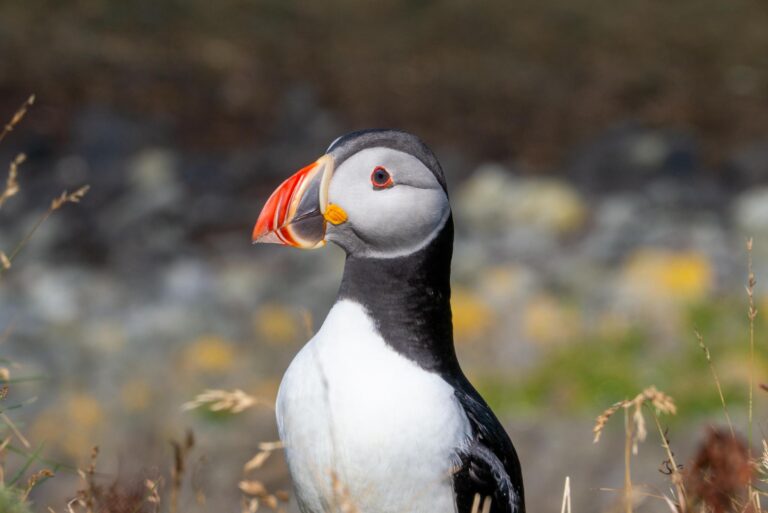
OTHER PLACES TO SEE PUFFINS IN SCOTLAND
#15 NORTH BERWICK, NEAR EDINBURGH
You may be able to spot Puffins around the North Berwick area, especially if you take a trip to the spectacularly square Bass Rock. There are a few trip operators, mostly focussed on the geometry and geology of Bass Rock. But, if you take this small boat tour with the Scottish Seabird Centre, you’ll maximise your chances of seeing Puffins.
The Scottish Seabird Centre really are the experts in this area, and they keep track of what’s been spotted recently. Seasonal highlights include puffins, guillemots, gannets and if you’re really lucky you might even spot dolphins. And the best part? North Berwick is accessible from Edinburgh by train!
If you need to warm up after your boat ride, stop off at the Drift Café. This café is one of my all-time favourites in Scotland, with beautiful views over the ocean and excellent cakes!
#16 ABB’S NATURE RESERVE, EYEMOUTH, SCOTTISH BORDERS
If you need to warm up after your boat ride, stop off at the Drift Café. This café is one of my all-time favourites in Scotland, with beautiful views over the ocean and excellent cakes!
Whether you’re lucky to see Puffins or not, the coast around St Abbs makes for a great walk. Wildflowers, such as sea pinks, rock rose, wild thyme and purple milk vetch, colour the grasslands and the dramatic cliffs overlooking crystal-clear waters are beautiful.
#17 INCHCOLM ISLAND, NEAR EDINBURGH
Also known as ‘The Iona of the East’, Inchcolm Island is worth a visit in itself. Just 6 miles from Edinburgh, with beautiful views over the Firth of Forth Bridges, the main attraction of Inchcolm is the 12th Century Abbey that was built there.
The best way to see Puffins on Inchcolm Island is to take a boat trip in spring and early summer. During the breeding season, a few Puffins nest on Inchcolm Island although they are better spotted by boat as they tend to hide away in the cliffs.
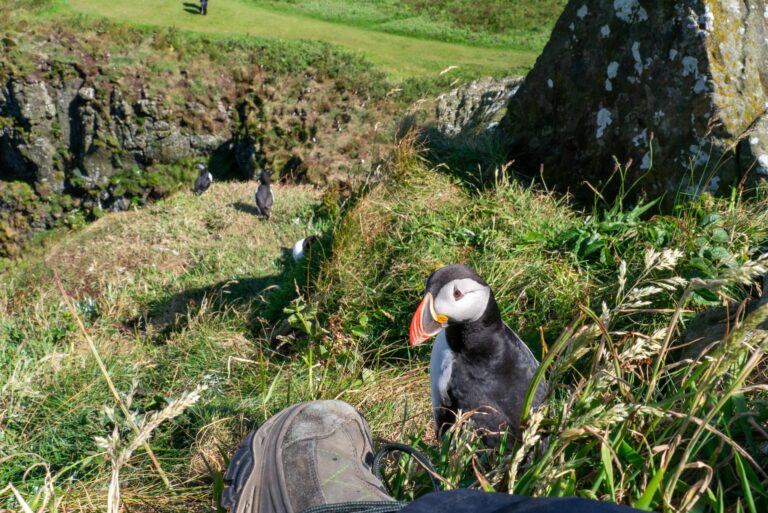
WHEN TO SEE PUFFINS IN SCOTLAND?
The breeding season lasts from late April to August. During this time, there are countless opportunities to watch Puffins at any of the places listed above. But, what you’ll see varies from month to month, as the Puffins’ activities change.
Late April to May
Arrival: Puffins start returning to their breeding colonies on the cliffs and islands of Scotland. By late April, the first arrivals can usually be seen.
Early Activities: If you head out to see Puffins in April to May, you’ll see puffins engage in courtship behaviors as they re-establish bonds with their lifetime mates. Puffins will be preparing their burrows for nesting. They may even fight among each other. This is a good time to see puffins coming ashore and settling in for the breeding season.
June to July
Peak Season: This period is the peak of the puffin-watching season. Puffins are highly active, feeding their puffling, and frequently flying back and forth between the sea and their nests. One Puffin always stays with the puffling, in and around the burrow. The other will be out at sea fishing. This means that there are good opportunities to see Puffins up-close on land, but also to observe them at sea, fishing.
Best Viewing: June and July offer the best opportunities to see puffins up close, both on land and in the water. Pufflings are hatched and being raised, so there’s plenty of activity.
August
Departure: By early August, Puffins start to leave their breeding colonies and head back out to sea. The exact timing can vary, but many colonies begin to empty out by mid-August.
Last Chance: Early August is your last chance to see puffins before they depart. The adults and pufflings gradually leave the nesting sites and return to the open ocean.
WHAT TO WEAR AND WHAT TO PACK TO SEE PUFFINS IN SCOTLAND
This may come as no surprise, but you should definitely bring weatherproof clothing to see puffins in Scotland. Our weather here in Scotland is famously unpredictable, and changes rapidly. Pretty much every day has forecast rain, but that doesn’t mean it will rain all day, or even at all. Most importantly, no two days are the same.
Bringing a waterproof jacket and waterproof trousers is essential to get the most out of your puffin-watching trip. Even if it’s not raining, waterproofs are essential to allow you to sit, crouch, and crawl on the floor as you try and get that perfect puffin photo.
Here’s what you should pack when visiting puffins in Scotland.
- Waterproof coat: essential. Never trust the weather in Scotland.
- Waterproof trousers: essential if you’re planning to do any sort of subtle bird-watching or photography without scaring the puffins off
- Camera and lenses: you’ll want to capture the charisma of these fun birds as we did!
- Binoculars: may be necessary to get a better view
- Insect repellant and tick-removing tools: we get a lot of ticks in Scotland. They can carry Lyme disease, so it’s important to check yourself after spending any time outdoors. Especially if you’ve been lying in the grass trying to get that perfect puffin photo!
- Snacks: some of the wildlife-watching tours go over lunchtime and food isn’t always provided. Bring snacks and water to keep the hunger at bay.

TOP TIPS TO PHOTOGRAPH PUFFINS IN SCOTLAND
There isn’t really a best time of day to photograph puffins. Puffins come and go all day. They tend to head off to fish early in the morning and spend the afternoon with the colony. But the photos you’ll get will differ, you may have more options to photograph puffins catching fish in the morning, and hanging out in the afternoon.
General tips for photographing puffins:
- As with any wildlife photography, patience is key. Be prepared to wait a while for the perfect moment.
- Try and keep your ISO low, although this can be difficult if the weather is cloudy (as it often is in Scotland!)
- If you want the background to be blurry and the puffin in focus then a larger aperture is needed. Set the aperture to between f/2.8 and f/5.6 for an out-of-focus background.
If you’re looking to capture puffins in flight:
- Find an area where the puffins are landing on a regular basis: usually around their burrows
- Increase the shutter speed up to at least 1/2000 of a second to eliminate movement in your photos
- Open the aperture fully (f/2.8) if possible
- Get comfy and wait!
This article has some great tips for photographing puffins and we recommend starting there.
WHERE TO SEE PUFFINS IN ENGLAND AND WALES
There are also a few places to see Puffins in England and Wales. These are:
- Farne Islands, Northumberland, England.
- Bempton Cliffs RSPB, Yorkshire, England.
- Puffin Island, Anglesey, Wales
- South Stack Cliffs, Anglesey, Wales
- Isles of Scilly, Cornwall, England
FINAL NOTES
Scotland’s diverse and dramatic coastal landscapes provide some of the best Puffin-watching opportunities in the world. Whether you’re exploring the remote islands of St Kilda or the accessible cliffs of the Isle of May, these locations offer unforgettable experiences for nature lovers and birdwatchers alike.
So grab your binoculars, pack your camera, and embark on an adventure to see Scotland’s beloved Puffins in their natural habitat.
If you explore any of these locations, we’d love to hear about what you thought. Leave a comment below, or drop us a message on Instagram!

FAQs
Can you see Puffins in Edinburgh?
No, you can’t. But you can see Puffins near Edinburgh, including over near Anstruther in Fife, and on Inchcolm Island and Bass Rock if you’re lucky.
Do I need to take a boat to see Puffins in Scotland?
Nope! There are plenty of places you can see puffins in Scotland on the mainland, including in Aberdeenshire, the Northwest Highlands, and around Edinburgh and the Borders.
Do I need to take a wildlife watching tour to see Puffins in Scotland?
Not always. Whilst some of the best places to see puffins in Scotland do need you to book onto an organised wildlife-watching tour, there are plenty of places to see puffins by yourself, at nature reserves. However, you will likely need your own car to get to these remote areas.
LIKE IT? PIN IT!
SAVE THIS POST TO YOUR PINTEREST BOARD TO COME BACK LATER


Follow our daily adventures on Facebook and Instagram
Disclaimer: The information and advice provided in this blog are the author’s opinions and based on their personal experiences. All information was accurate at the time of writing. However, things can change quickly, so always double-check current conditions and guidelines before setting out. Remember, your travels and safety are your own responsibility, and this blog can not be held responsible for anything that might happen on your adventures! Always exercise caution and good judgment. Oh, and don’t forget to get travel insurance! Happy travels!
This post may contain affiliate links (yay for transparency!) This means that I will earn a small commission, at no additional cost to you, if you click the link and choose to buy the product. I only link to stuff I have personally bought and found useful and never endorse crap. Your support helps keep the site going, thank you!
Alice
Alice is a UK travel blogger who advocates sustainable travel and being more eco-conscious on a budget. She loves coffee, her houseplants and summiting mountains.
You May Also Like

Cycle to Cramond | Edinburgh things to do 2025
October 17, 2020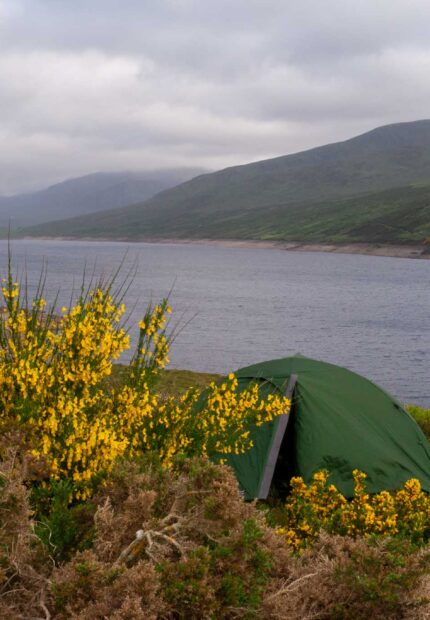
Wild Camping on the Isle of Mull: Know before you go
July 27, 2024